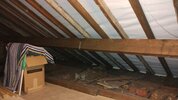I'd like to know if anyone else has a roof supported similar size (9x3) pair of purlins at 6m spans, or if a previous owner may have removed some type of structural support.


Question has arisin after having roof retiled from original clay to concrete double Romans. I calc a total load change from 2.5 tonnes to 3.5 tonnes, so just under 50% increase per sqm.
There are no struts to shorten span. roofer didn't think it was any issue as purlins are "big" but a structural engineer on site for another issue said it needs reinforcing by thickening the middle.
95 year old house. Only slightest deflection visible now.
There's also 2 spliced timbers running parallel to the each Purlin, but totally independent and on top of ceiling joists, but fixed into party walls: I just can't visualise what they are doing structurally, unless some ceiling joists are 'hanging' from them, even though the are mostly resting on top of walls below.


All very mysterious.... all insights welcomed.
Question has arisin after having roof retiled from original clay to concrete double Romans. I calc a total load change from 2.5 tonnes to 3.5 tonnes, so just under 50% increase per sqm.
There are no struts to shorten span. roofer didn't think it was any issue as purlins are "big" but a structural engineer on site for another issue said it needs reinforcing by thickening the middle.
95 year old house. Only slightest deflection visible now.
There's also 2 spliced timbers running parallel to the each Purlin, but totally independent and on top of ceiling joists, but fixed into party walls: I just can't visualise what they are doing structurally, unless some ceiling joists are 'hanging' from them, even though the are mostly resting on top of walls below.
All very mysterious.... all insights welcomed.
Attachments
Last edited:


